David K
Honored Nomad
        
Posts: 65399
Registered: 8-30-2002
Location: San Diego County
Member Is Offline
Mood: Have Baja Fever
|
|
EL BARRIL ROCK HOUSE: Mormon mission or ???, a story from Choral Pepper.
Preview:
Yesterday BajaTripper (Steve), Zully and Nikki arrived from La Paz at our Oceanside home on their way north to visit 'bajalera' (Steve's mother). They
had come by way of Mision Santa Gertrudis, the painted cave near El Arco, and then went to El Barril (on their way north to Bahia de los Angeles and
San Diego).
Steve asked me about the big building above the beach there and I remembered Choral Pepper had a chapter about it in here last book:
'Baja's Missions, Mysteries and Myths' (unpublished).
Steve being a history loving guy, wanted to know more and I knew he would like to read that chapter so I pulled out of my Choral Pepper file.
While the Mormon connection may be the fact, and the rock house is built much like Fort Callville (now under Lake Mead), there may be a less dramatic
explanation for its existence? I invite anyone who knows more about the mystery house at El Barril to please add it here.
I have added two of Choral Pepper's photos of the rock house. She took them in 1966 with the Erle Stanley Gardner expedition south from Bahia de los
Angeles. Pepper first wrote about the Rock House in her third 'Magic of Baja' series (August/September 1966) of her Desert Magazine.
THE MYSTERY OF THE OLD ROCK HOUSE
Purple clouds moved over the sun as we picked our way along the rutty road to El Barril. When a sturdy old building suddenly took form through the
mist, it appeared as spooky as an Addam’s Family stage set. Weathered doors that once opened onto an encircling balcony were cracked, and the balcony
sagged, but the three stories of masonry had been executed with such precision that they seem destined for eternity. The sole occupant within those
empty walls is said to be a benevolent ghost, but the rock house of El Barril (not to be confused with El Barril on the Cape) arose long before the
ghost.
Standing high beside a protected port, it harbored both foreign and Mexican pearl smugglers around the turn of the last century when Baja’s pearl beds
were being exploited for exportation. Hillocks of eroded, bleached shells that surround the house lay as testimony to those independent entrepreneurs
who took advantage of the rock house’s secluded location to carry on their business in a tax-free atmosphere. But that wasn’t the original purpose of
the house. The intent of the German gentleman who built it was not to provide housing for pearlers, although he did have the smuggling of another,
more astonishing commodity in mind.
In 1864, Mormons in the Utah territory were having trouble with the United States government. A military fracas seemed imminent. Expected freight
shipments that had to be carried thousands of miles across prairies and mountains from eastern markets often failed to arrive, but worse, so did newly
converted European immigrants called to their Zion in Salt Lake City. To alleviate this desperate situation, Brigham Young conceived of a novel plan.
He would establish a port on the Colorado River near the fringe of the Utah territory and transport his European saints directly into the arms of Zion
via the Gulf of California to the head of navigation on the Colorado River,
Anson Call was dispatched to do the job. In record time, Fort Callville, which today lies under Nevada’s Lake Mead, arose on the banks of the Colorado
River about forty miles south of St. Thomas, a farming community on Utah’s Muddy River also now inundated by Lake Mead. With the help of fellow saints
from the Muddy River mission, Brother Call constructed a massive rock-walled warehouse 120 feet long by 30 feet wide and a substantial rock residence
for himself, both similar in structure to the rock house at El Barril.
With his storerooms completed by February, Call received a discouraging blow. It would be at least three months before anything would arrive to store
in them. Steamboats made regular progress to mines and ore mills located along the lower Colorado River, but those at the upper end had to be
ring-winched through the treacherous Black Canyon rapids. During many months of the year the water was too high and swift, or too low, to permit safe
navigation. Call learned that the best he could hope for would be three trips per month from July to November. This necessitated a plan for
safekeeping merchandise and converts brought up the Gulf on ocean-going vessels from distant ports until such time as they could be transferred aboard
a sternwheeler and transported up the Colorado to Fort Callville.
At first it was believed that gentiles (non-Mormons) at ports south would cooperate by holding goods until the upper waters became navigable, but less
than a month after the warehouse was ready for business, a steamboat captain commissioned by the Mormons to carry their freight to Fort Callville
encountered opposition. “The ports below seem to be jealous of the Mormon post,” he complained to the editor of the Deseret News. The brethren were
forced to make an independent arrangement along the Gulf of California until such time as their converts and supplies could be transported north.
El Barril had been known since Spanish days as an emergency water stop for vessels. Its remote, but accessible, location on the Gulf lent itself
ideally to the Mormon’s requirement for a place to conduct business in utmost secrecy. A German convert from the Muddy River mission, who had helped
in the construction of Fort Callville, was placed in charge. Soon the rock house rose on the beach above the luminous waters of the Gulf.
The rare Mexican vaquero who worked his way from the inland mission trail through forty-seven miles of wicked chaparral and nightmare masses of
granite to reach water at El Barril was content to believe the fancy quarters found there were built by a German trader who bartered ironwood for
goods from passing ships. Little did he know that further north such business was conducted by Indians who piled wood beside a rusty container into
which boat captains deposited chits redeemable at trading posts.
Records in Mormon archives of this endeavor are scant because the “Mormon Mission” of Baja was short lived. They made peace with Uncle Sam and the
completion of the Union Pacific Railroad promised safe delivery of freight at reasonable cost. In 1869 plans for shipping immigrants and freight to
Salt Lake City via the Colorado River were declared “unprofitable” by the Church. Both Fort Callville and El Barril were abandoned.
With time, the rock house at El Barril fared better than the old Mormon fort. Convert smugglers moved out; pearl smugglers moved in. The latter made
little use of the rock walls, finding them oppressive compared to their native mud-roofed huts with airy ocotillo walls, but water here was fresh and
in the shadeless desert it was pleasant to recline in the shadow of the old house while they shucked oyster shells.
Eventually the rock house was sold to a mining syndicate that operated inland at Calmalli and El Arco. During the mining heyday of the late 1880s, its
sturdy walls protected supplies arriving by boat, but when the mines ran out it reverted to its predestined purpose.
Prior to World War II, the Mexican government decreed it illegal to export live lobsters from Mexican waters to markets above the border. In contrast,
Uncle Sam welcomed Mexico’s Western lobsters. This resulted in another busy smuggling industry. Flyers, called “bug pilots,” cleared primitive runways
in remote spots along Baja’s coasts where they landed on prearranged schedules to pick up lobster from native fishermen. Because the shellfish had to
be delivered alive above the border, time was of the essence. Planes flown by these men were decrepit and small. The air routes they took to evade
detection were unsafe. But wind or rain, bug pilots landed on death-defying terrain or took off into solid clouds, dependable as the United States
mail used to be. Later, during the war, these same flyers were in demand to instruct bush pilots, and after the war many became commercial pilots.
But during their exciting days of trafficking in the lobster industry, it was not unusual for a pilot to arrive on an evening prior to an
early-morning appointment with his suppliers. In that event, the old rock house gave convenient shelter near the primitive landing strip that today
delivers rich vacationers to elaborate new houses rising on the beach at El Barril or to gringo fishermen coming to the nearby resort at Bahia San
Francisquito.
HERE IS the BOOK Chapter hard copy:
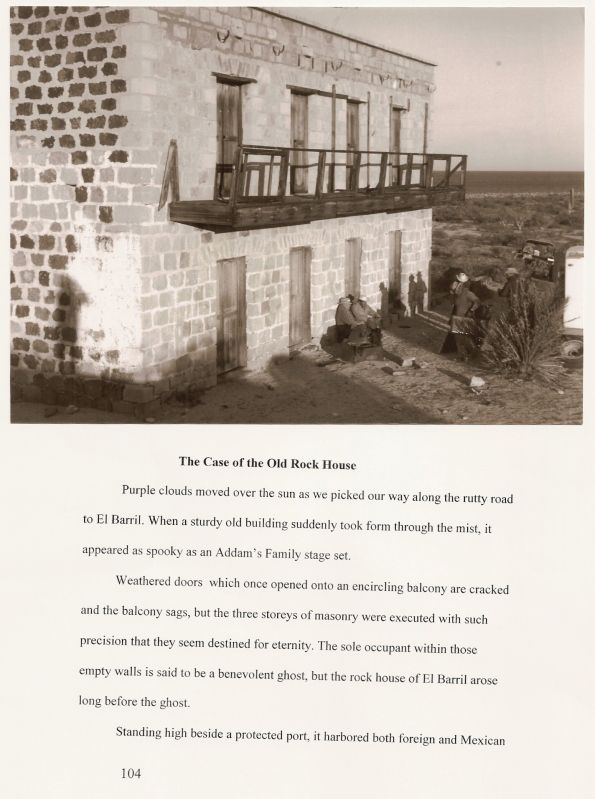
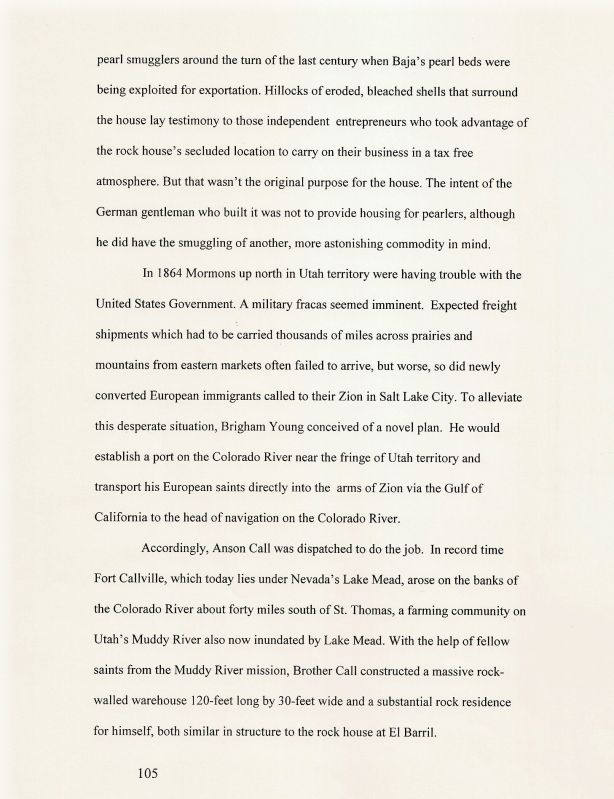
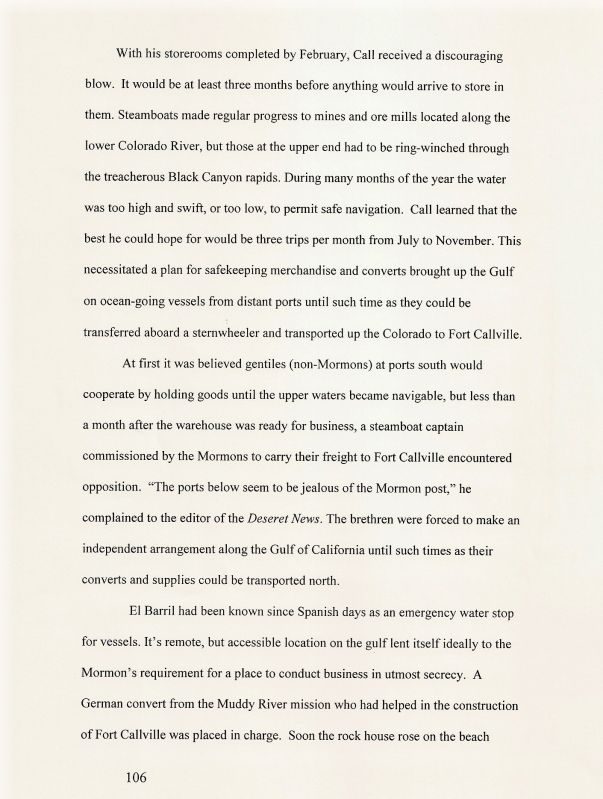
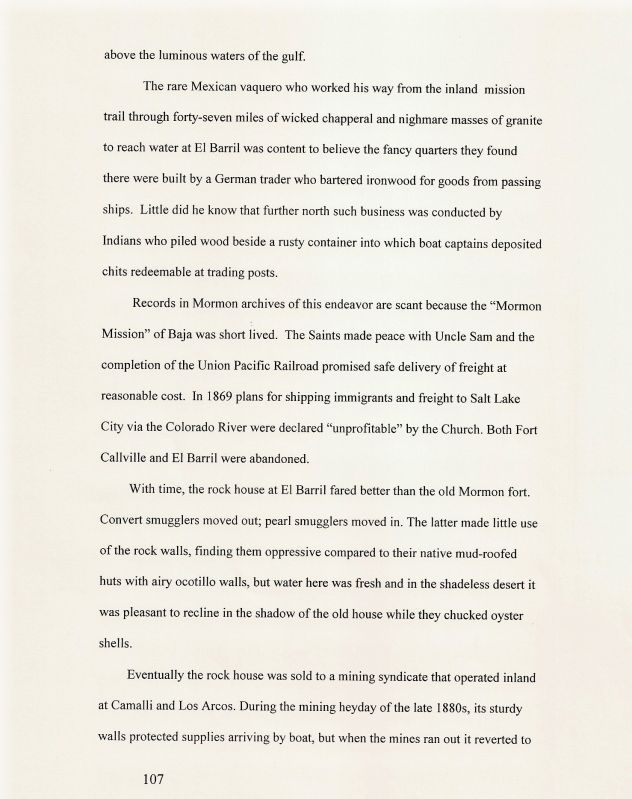
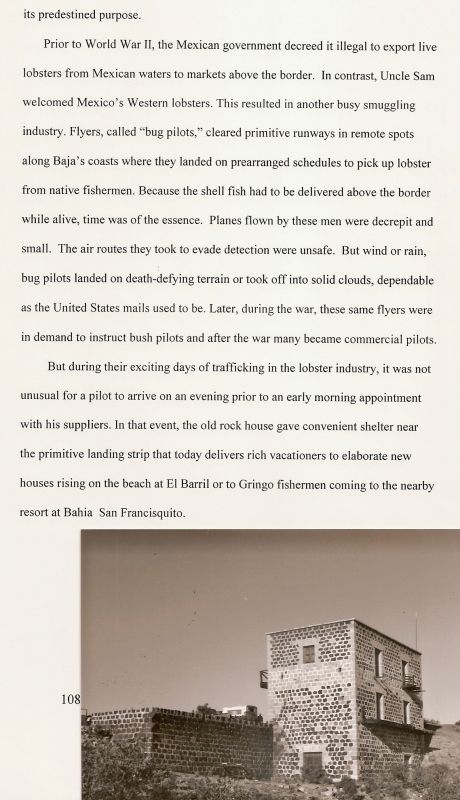
(for the spell checkers, the gold towns were CALMALLI and EL ARCO)
Fort Callville antique photo, now at the bottom of Lake Mead, east of Las Vegas:
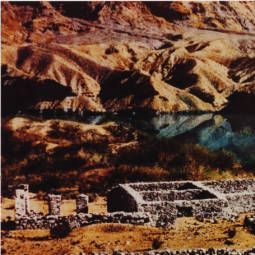
[Edited on 8-31-2012 by David K]
|
|
|
David K
Honored Nomad
        
Posts: 65399
Registered: 8-30-2002
Location: San Diego County
Member Is Offline
Mood: Have Baja Fever
|
|
I had originally posted this chapter five years ago, and John M had a good reply:
| Quote: | Originally posted by John M
Below is a photo of the rock structure David referred to in the opening post of this thread.
Choral Pepper called it Fort Call. Stanley W. Paher, in his book Callville Head of Navigation Arizona Territory wrote “Many referred to it as ‘Fort
Call,’ probably because of the massive warehouse walls.”
Additionally there was a detachment of military – Companies D and then K - Fourteenth Infantry - there for a time, early February 1867 until May of
1868. (Casebier Camp El Dorado, Arizona Territory), perhaps this also contributed to the Fort Call idea.
The photograph of the stone structure pictured here was taken in the 1930s just before being flooded by Lake Mead. (photo from: Steamboats on the
Colorado River by Richard E. Lingenfelter).
The establishment there was more commonly referred to as Callville.
John M.
|

|
|
|
Barry A.
Select Nomad
      
Posts: 10007
Registered: 11-30-2003
Location: Redding, Northern CA
Member Is Offline
Mood: optimistic
|
|
My friend and I had lunch beside that building about 10 years ago when we were providing logistics for 2 kayaking friends doing the paddle from the
Colorado River south to Mulege. It is an impressive structure, for sure, looked very solid at the time, but was not being used other than storage for
bulky fishing gear & nets of the local fishermen. That whole area is pretty interesting, including the rancho at El Barril itself, very close by.
Unfortunately I do not have any digital pictures since mine are all slides.
Barry
|
|
|
David K
Honored Nomad
        
Posts: 65399
Registered: 8-30-2002
Location: San Diego County
Member Is Offline
Mood: Have Baja Fever
|
|
Speaking of slides... I have hundreds... wow... more work to convert them to digital!
|
|
|
David K
Honored Nomad
        
Posts: 65399
Registered: 8-30-2002
Location: San Diego County
Member Is Offline
Mood: Have Baja Fever
|
|
Hope more Nomads who have been to El Barril or have some insight on the Mormon or mining or pearling connection with this 3 level building will post
their thoughts or information!
|
|
|
David K
Honored Nomad
        
Posts: 65399
Registered: 8-30-2002
Location: San Diego County
Member Is Offline
Mood: Have Baja Fever
|
|
This building came up on a Facebook post on Talk Baja.
|
|
|
|

